How To Make A Backyard Waterfall And Pond
How to Build a Pond and Waterfall in the Backyard
Spend more time enjoying a backyard pond and less time maintaining it.
 Family Handyman
Family Handyman
A backyard garden pond with running water, floating plants and darting fish can make a bland space breathtaking. Keeping it attractive and trouble free takes work, but with a little extra care at the planning and building stages, you can create a pond that's almost maintenance-free.
You might also like: TBD
- Time
- Complexity
- Cost
- Multiple Days
- Beginner
- Varies
How to Make a Pond: Pick a Sunny Spot
If your yard has only one spot that will accommodate a pond, don't worry—you can create a great garden pond in just about any location. But if you have two or three spots to choose from, consider the upkeep factor.
If you locate your pond in an area that gets at least six hours of direct sunlight each day, you'll have a wide variety of easy-to-care-for plants to choose from. Plants that thrive in shade are available too, so you can create a pond in a spot that never gets direct sunlight. But you'll have fewer easy-care choices and you may have to pay a bit more to get the mix of plants you want.
There is such a thing as too much sun, though. In the Southern United States, choose a site that gets shade in the afternoon. Afternoon sun can overheat the water; that can harm fish and plants and cause algae to flourish.
How to Make a Pond: Build in 'easy-care' features
A. Leave workspace all around the pond
For convenient care of plants and the pond itself, it's best if you can reach all parts of the pond easily. If you locate your pond right next to a fence, wall, hedge or building, you'll have to get into the water to tend that part of the pond. Instead, leave a workspace at least 2 ft. wide all around the pond.
B. Provide a winter home for plants
One way to preserve plants through harsh winters is to keep them in buckets indoors. A more convenient method is to create a deep area in your pond. Keep your aquatic plants in pots or root sacks and you can move them to the deep water in the fall. The necessary water depth depends on your climate and plants. Placed in 3 ft. of water, hardy plants will survive in even the coldest climates.
C. Extend the liner to prevent a plant invasion
Even plants that normally grow on dry land love water, and some want to spread into the water along the pond's edge. To prevent an invasion as you determine how to build a pond, run the liner 12 in. or more beyond the pond's edging stones and cover it with mulch or gravel. The rubber liner will block water-seeking roots.
D. Make a mow-over border where garden meets grass
Flat stones set at ground level create a lawn mower–friendly transition between your pond and lawn. Instead of trimming the grass where it meets the pond-surrounding boulders or plants, you can run the lawn mower right over the stone border.
E. Make your pond easy to empty
To prepare for winter or to clean the pond, most pond owners occasionally pump out the water. To make your pond easy to pump dry, slope the floor gradually toward a sump hole. That way, you can set a pump in a single spot to discharge all the water. Make the sump hole dish-shaped and no more than 3 in. deep so the liner can conform to it.
F. Place the skimmer in an easy-access spot
Skimmers, filters and waterfall tanks collect debris (mostly leaves and other plant parts) and require occasional cleaning. If you plan to use one, don't put it in a spot that can only be reached by crawling over rocks or trampling plants. The stuff you take out of a skimmer is great fertilizer for plants. Plant a patch of hostas or other leafy cover next to the skimmer. The large leaves hide the debris while it decomposes and nourishes the plants, and you save yourself a trip to the trashcan.
G. Cut steps into the soil for easy access
Steps make it easy to get in and out of your pond, whether you need to clean it, care for plants or just cool off on a hot day. Steps also act as shelves for pots, providing different water depths for different plants. If it will hold plants, the top step should be covered by at least 6 in. of water. Steps that fall 12 in. or more below the water line should be at least 20 in. wide to accommodate large pots. If your pond is too small for built-in steps, create an entry point where the side of the pond is vertical. Sloped sides make getting in and out difficult.
 Family Handyman
Family Handyman
Trees add to the work load
Falling leaves mean extra upkeep
The closer your pond is to trees, the more time you'll spend fishing out leaves with a net or cleaning out your skimmer. With some trees, this is only a problem in the fall, and some pond owners stretch a net over the water for a couple of weeks in autumn. But other trees (certain varieties of maple, for example) also drop seeds in spring and summer. You can't let leaves, seeds or pine needles build up and sink to the bottom. They'll turn the water brown. Natural chemicals in leaves and in the decomposition process can also kill fish.
Beware of tree roots
There are two reasons, aside from falling leaves, to keep a distance between your pond and trees. Growing tree roots can poke holes in a pond's liner. And digging a pond hole can destroy roots and injure or even kill a tree. Here's a rough formula to determine how far roots extend from a tree's trunk:
- Measure the diameter of the trunk (in inches) about 4-1/2 ft. from the ground.
- Multiply that diameter measurement by 1.5.
- The result tells you how many feet the roots extend.
Example: Let's say the trunk is 10 in. thick: 10 in. x 1.5 = 15. So in this case, the roots extend about 15 ft. from the trunk.
If you can't place your pond away from root zones, consider an above-ground pond. Above-ground ponds are created by piling up soil to form dikes or by building retaining walls to contain the pond.
Drain Runoff Away from Pond
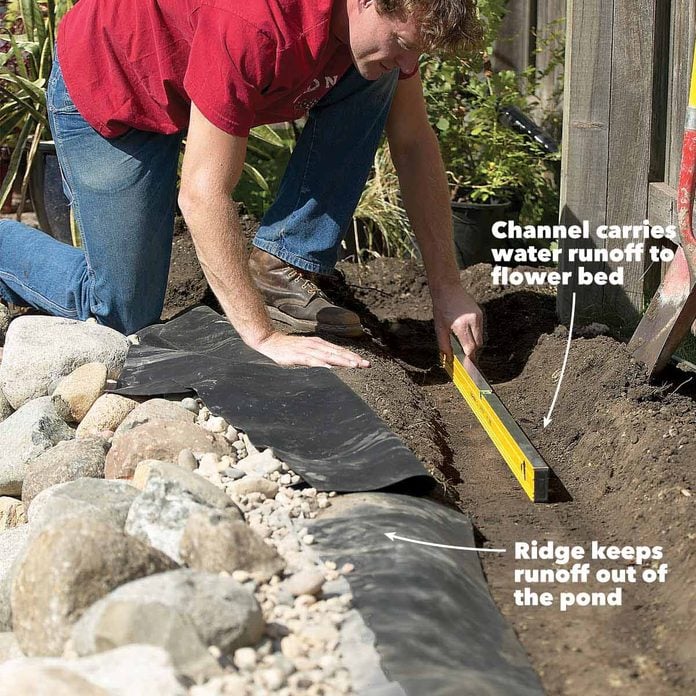 Family Handyman
Family Handyman
Runoff from your yard can carry silt, grass clippings and other debris that lead to murky water. It also contains lawn chemicals that can support algae growth or harm plants or fish. You can protect your pond from runoff by simply forming a slight ridge around it as you begin figuring out how to build a pond. It doesn't have to be very high; 3 in. is usually plenty. If the pond is on an incline, you can create a shallow channel with a slight slope to divert runoff to a garden or flowerbed.
Stop Leaks Before They Start
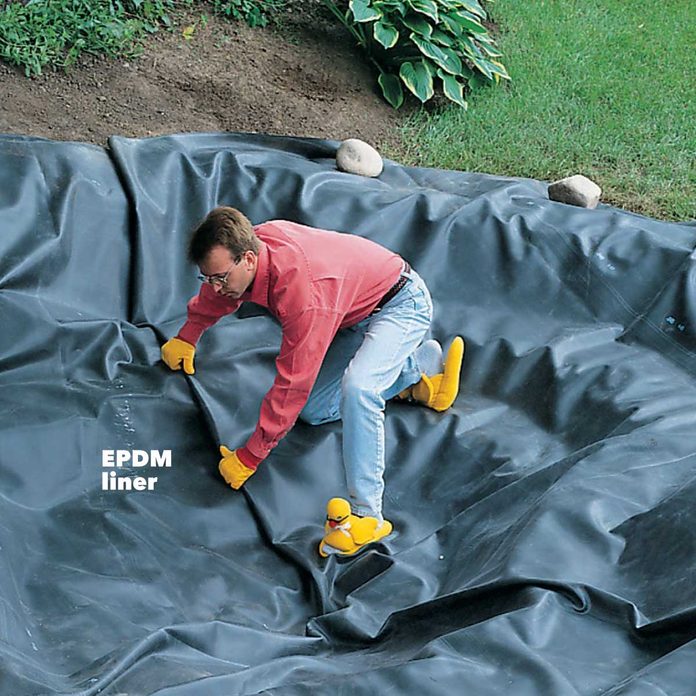 Family Handyman
Family Handyman
Use tough EPDM liner obtained from a pond supplier for the pond as you start planning how to build a pond.
Underlayment
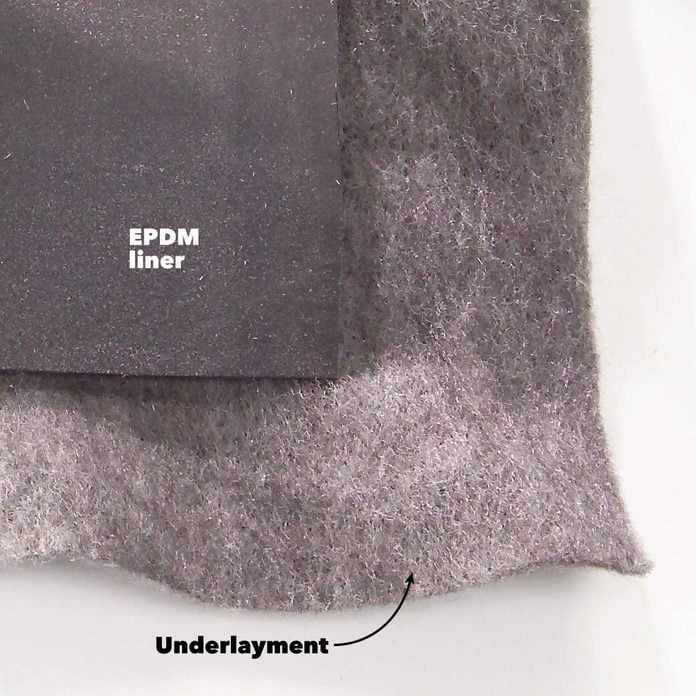 Family Handyman
Family Handyman
Underlayment cushions the EPDM liner from rocks and roots. Commercial underlayment is available at pond suppliers.
Carpet Underlayment
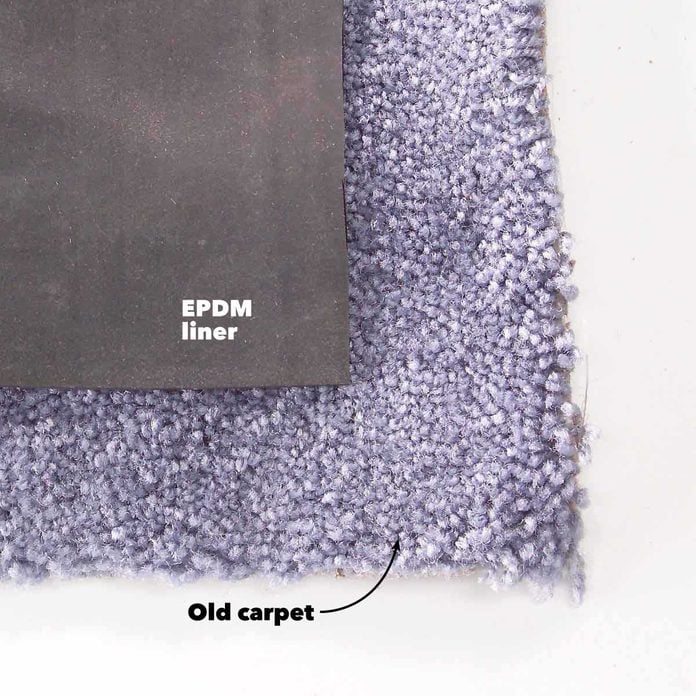 Family Handyman
Family Handyman
To save money, you can substitute old carpet for commercial underlayment under the EPDM. Make sure all the nails and staples are removed.
Add Extra Padding
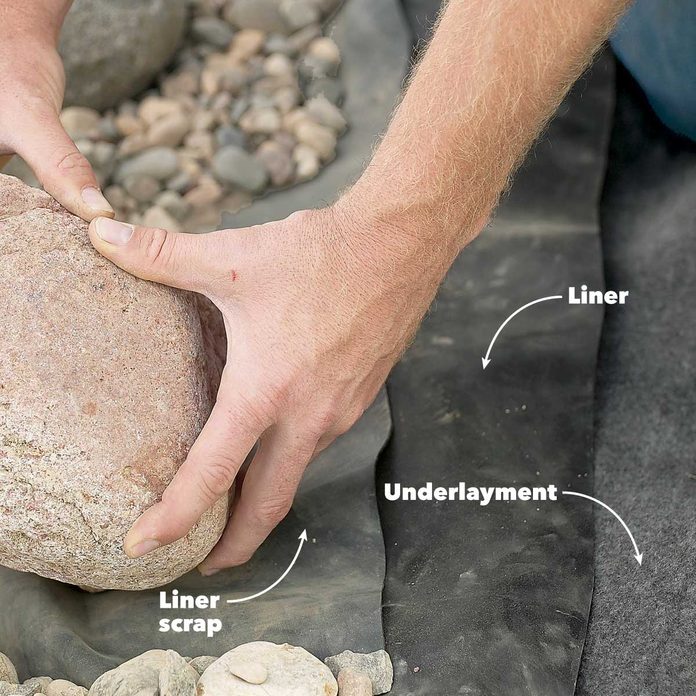 Family Handyman
Family Handyman
Heavy rocks and walking areas need extra protection to protect against tears and holes. Cushion these vulnerable spots with scrap pieces of EPDM.
Pack the Soil Under Preformed Liners
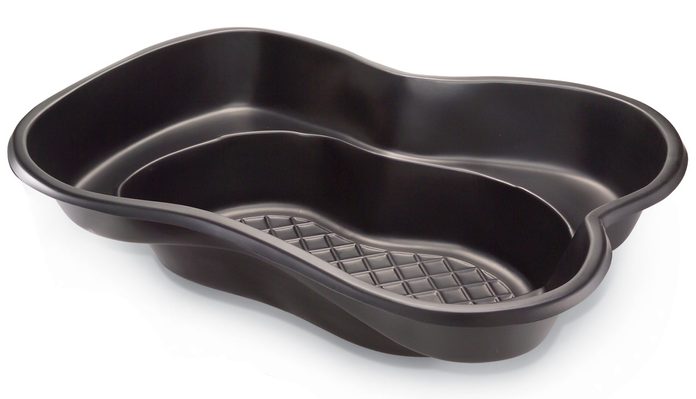 Family Handyman
Family Handyman
Voids underneath preformed liners can eventually crack from the weight of the water. Pack loose soil or sand under and around the liner when you install it and as you fill it with water.
A small leak in a flexible liner can be a big deal, not because leaks are hard to repair, but because they can be difficult to find. In the worst cases, you have to drain the pond, remove rocks or even remove the whole liner to examine it. Extra care during installation is worth it.
Line your garden pond with 45-mil EPDM
EPDM rubber is the only material most professional pond installers use. EPDM costs more than most other materials, but the pros have learned that it's better to spend a few extra bucks than to seek and fix leaks later. Get the thick stuff (45 mil) only from a pond supplier. EPDM is also used for roofs, but the version sold by roofing suppliers often contains fungicides that can harm plants or fish.
Protect the liner with underlayment
Underlayment provides a cushion that protects the underside of the liner against rocks and roots. Don't skip it. Commercial underlayment is synthetic cloth sold by pond suppliers. With a little legwork, you can get free underlayment—old carpet and padding—from a carpet installer. Call an installer or carpet store to find some. Just be sure to examine the carpet closely and remove any staples.
Avoid seams
Sections of EPDM can be bonded together with a special adhesive, tapes and sealants. If this is done correctly, the bond will be strong. But bonding seams is time-consuming, and seams are more likely to leak than the rest of the liner. If possible, avoid seams completely by buying a single piece to line the entire pond (most suppliers can order 50 x 100-ft. pieces). Never try to save money by quilting scraps of material together. Don't worry if your liner comes with seams already in it. These factory seams are as reliable as the rest of the liner.
Install liners with TLC
Leaks in flexible liners are usually caused by punctures. Here are some tips to protect your liner:
- Inspect the pond hole before you install the underlayment. Pick out any sharp stones.
- Wear soft-soled shoes and walk on the liner only when you have to.
- Spread the liner loosely inside the pond; don't stretch it tight.
- Place leftover scraps of liner material under large stones and in areas where you expect to walk. This helps to protect the liner itself from punctures.
- If you put cattails in your pond, plant them in containers and set them on flat stones. Cattail roots can grow into liners.
Support preformed liners with compacted soil
When preformed plastic liners leak, it's usually because they weren't installed properly. To avoid cracking, preformed liners must be fully supported by the surrounding soil. Dig a hole slightly larger than the liner and compact soil around it as you backfill.
Required Tools for this How to Build a Pond Project
Have the necessary tools for this DIY how to make a pond project lined up before you start—you'll save time and frustration.
Required Materials for this How to Make a Pond Project
Avoid last-minute shopping trips by having all your materials ready ahead of time. Here's a list.
Similar Projects
How To Make A Backyard Waterfall And Pond
Source: https://www.familyhandyman.com/project/build-a-backyard-pond-and-waterfall/
Posted by: bauerwone1985.blogspot.com

0 Response to "How To Make A Backyard Waterfall And Pond"
Post a Comment